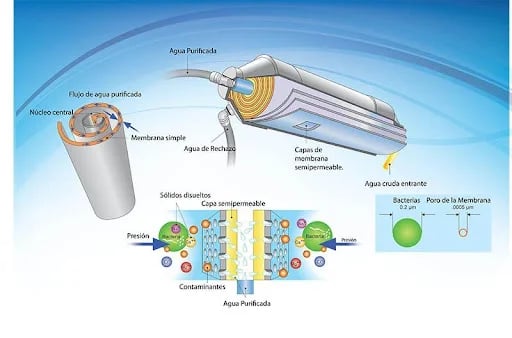Reverse Osmosis Technology
2/20/20252 min read


Understanding Reverse Osmosis: How It Works and the Role of the Membrane
Access to clean, safe drinking water is essential for healthy living. One of the most effective technologies used today to purify water is Reverse Osmosis (RO). This advanced filtration method is widely used in homes, industries, and medical facilities due to its efficiency in removing contaminants. But how exactly does reverse osmosis work, and what makes the RO membrane so important?
What Is Reverse Osmosis?
Reverse osmosis is a water purification process that removes dissolved salts, heavy metals, bacteria, and other impurities from water by applying pressure to force it through a semipermeable membrane. The process is the opposite of natural osmosis, where water flows from a region of low solute concentration to high concentration. In reverse osmosis, the flow is reversed using applied pressure.
How Reverse Osmosis Works: Step-by-Step
Pre-Filtration
Before water reaches the RO membrane, it passes through pre-filters that remove large particles like sediment, rust, and chlorine. This step is essential to protect the membrane from damage.Application of Pressure
Pressure is applied to the feed water to overcome natural osmotic pressure. This forces the water to move through the RO membrane, leaving most contaminants behind.Membrane Filtration
The RO membrane is the core component of the system. It contains microscopic pores (~0.0001 microns) that allow only water molecules to pass through, blocking dissolved solids, microorganisms, and chemicals.Storage or Immediate Use
The purified water (also known as permeate) is collected in a storage tank or dispensed directly. The rejected water (called concentrate or brine) containing impurities is flushed away.
The Role of the RO Membrane
The RO membrane is the heart of the reverse osmosis system. It's a thin-film composite (TFC) made of multiple layers, designed to:
Reject up to 99% of contaminants such as lead, arsenic, fluoride, nitrates, bacteria, and viruses.
Operate under high pressure (typically 50-100 psi in household systems).
Provide high-quality water with minimal dissolved solids (TDS).
Proper maintenance and periodic replacement of the membrane are essential to ensure optimal system performance and water purity.
Why Choose Reverse Osmosis?
✅ Removes a wide range of contaminants
✅ Improves taste and odor of water
✅ Safe for cooking, drinking, and baby formula
✅ Ideal for households using tap or borewell water
Conclusion
Reverse osmosis is a powerful and reliable water purification method that uses pressure and a semi-permeable membrane to deliver safe, clean drinking water. Whether you're looking to improve your home’s water quality or protect your family’s health, understanding the RO mechanism helps you make informed decisions.
If you're interested in installing a high-quality RO system, Ghadeer Al Naqaa provides expert solutions tailored to your needs. Contact us today for a free consultation!
Purity
Premium water filtration for healthier lifestyles.
Eco-friendly
Reliable
info@ghadeeralnaqaa.com
© 2025. All rights reserved.
